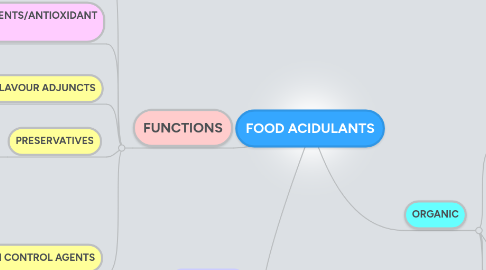
1. FUNCTIONS
1.1. CONTROL OF GELATION & COAGULATION
1.1.1. play a significant role in gelation of pectin and algins
1.1.2. For gelling high methoxyl pectin, pH must be adjusted to 2.5-3.5
1.1.3. Provides precise pH control
1.2. CHELATING AGENTS/ANTIOXIDANT SYNERGISTS
1.2.1. have ability to form ring structure with metal ions
1.2.1.1. citric acid
1.2.1.2. lactic, malic and tartaric acid
1.2.2. prevent metal ions from reacting with other materials or from reacting as catalysts for reaction
1.2.3. synergists for antioxidants in preservation of fats and oils, food product contain fatty compounds.
1.2.3.1. BHA, BHT, ascorbates
1.3. FLAVOUR ADJUNCTS
1.3.1. Modify or enhance food flavour
1.3.1.1. tartaric acid in combination with grape
1.3.1.2. phosphoric acid with cola flavours
1.4. PRESERVATIVES
1.4.1. an acid pH can stop growth or enhance effectiveness of heat sterilization or antimicrobial effect of solutes
1.4.1.1. in extreme case, destroy the organisms
1.4.2. Antibrowning agents to maintain normal flavour, colour, texture of canned fruits and vegetables
1.5. pH CONTROL AGENTS
1.5.1. Obtain certain pH range in product formation
1.5.2. Acidulant reaction with baking soda is essential in the leavening reaction of carbon dioxide
1.5.3. Maintain acidic pH and tartness of carbonated beverages
1.5.4. Acidulants benefits products that use preservatives
1.5.4.1. sodium benzoate
1.5.5. Buffering capacity
1.5.5.1. control the amount of free H+ ions
1.5.5.2. Provide protection from pH dependent effects like color or flavour
1.5.5.3. maintain acidic fermentation process
2. INORGANIC
2.1. PHOSPHORIC ACID
2.2. HYDROCHLORIC ACID
2.3. SULFURIC ACID
3. ORGANIC
3.1. CARBOXYLIC ACIDS
3.1.1. MONOCARBOXYLIC ACIDS
3.1.1.1. acetic acid
3.1.1.2. propionic acid
3.1.1.3. lactic acid
3.1.2. DICARBOXYLIC ACIDS
3.1.2.1. malic acid
3.1.2.2. tartaric acid
3.1.2.3. adipic acid
3.1.2.4. fumaric acid
3.1.3. TRICARBOXYLIC ACIDS
3.1.3.1. citric acid
3.2. PHENOLIC ACIDS
3.2.1. benzoic acid
3.3. FATTY ACIDS
3.3.1. sorbic acid
3.3.2. caprylic acid
3.3.3. butyric acid
3.4. LACTONES
3.4.1. ascorbic acid
3.4.2. gluconolactone
